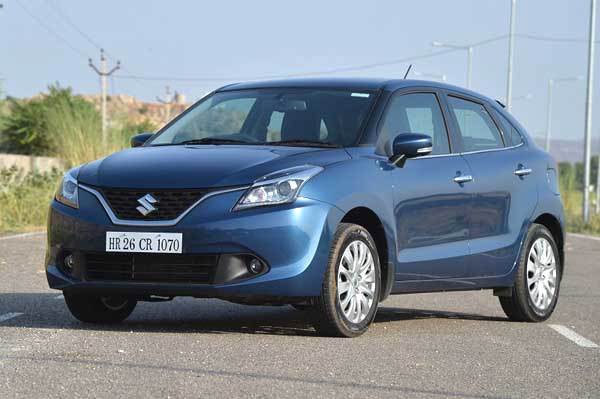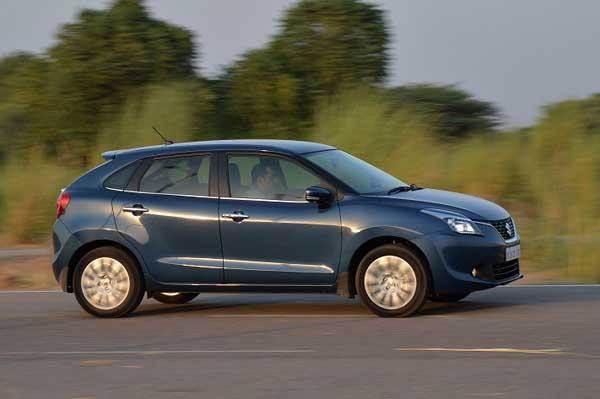Maruti Baleno review, test drive
The all-new Baleno is the best looking Maruti hatchback yet. But does it pack in enough to give the i20 and Jazz a run for their money?
Published on Oct 13, 2015 04:52:00 PM
4,54,904 Views
Follow us on



Internationally, the Baleno will be sold with a 1.0-litre turbo-petrol engine. Sadly, India won’t get that engine, at least for now. Instead, the Baleno will be offered with Suzuki’s 1.2-litre K12 engine and the Fiat-sourced 1.3 DDiS diesel. Both engines come mated to five-speed gearboxes though the petrol car can additionally be had in an automatic variant with a CVT.
The diesel Baleno gets the lower powered version of the ubiquitous 1.3 DDiS motor now badged DDiS 190. It’s essentially the same 75bhp unit that powers the Swift but in slightly different state of tune and being a 100kg lighter, the diesel Baleno feels more sprightly too.
There is still a fair amount of turbo-lag below 2,000rpm but the overall power delivery is more linear now. On part throttle or for normal city driving, the Baleno is fairly responsive and, thanks to the light weight, is almost as quick as the more powerful Hyundai i20 diesel up to 100kph. It’s only when you floor it at low revs for a quick overtake that the engine gets bogged down. The engine is fairly free revving for a diesel and easily goes past 5,000rpm but beyond 3,000rpm, the engine is quite noisy and it’s best to upshift early. The engine is quite noisy and refinement of the Fiat-sourced engine, which is now clearly showing its age, is poor by today’s class standards. The bright spot though is the exceptional fuel economy Maruti claims to have wrung out of it – 27.39kpl.
Suzuki’s in-house petrol 1.2-litre K12 motor, which powers a wide range of models, is an absolute jewel that sparkles even more in the lightweight Baleno.
Again, the 100kg weight saving has given it an eagerness that was missing in the Swift. The lower weight and short first and second gear ratios mask the K12’s inherent weak bottom-end and flat mid-range. As a result, the manual petrol Baleno is quick off the line and on part throttle, scoots through gaps fairly well. There’s a bit of a gap between second and third gear which has relatively tall ratio and this necessitates more frequent downshifts from the third to second, to stay in the meat of the engine’s powerband. What’s truly impressive about this motor is how smooth and refined it is. There’s no hint of harshness even when you rev it to its rather conservative 6,200rpm limit.
The gearshift too is slick and allied to a light clutch, you may not feel the need to go in for an automatic. But if you do, there’s a CVT automatic option available only on the petrol and the good news is that it doesn’t come at the expense of fuel economy. According to the official figures both the manual and automatic petrols give an identical 21.4kpl, which again, is best in class.
At low speeds, the CVT is incredibly responsive. Just tap the throttle and the Baleno shoots forward with the immediacy of a manual. However, go past 4,000rpm and the CVT’s ‘rubber band’ effect comes into play. The revs shoot up without a corresponding increase in speed which make the engine sound constantly strained. Put your foot down and the engine spins to 6,000 rpm and stays there whilst the Baleno slowly gathers speed. The CVT is clearly not a highway chomper and is best left within city limits where it excels as an effortless commuter. It’s a real shame then that the CVT option only comes in the mid-level Delta spec. Maruti’s logic not to offer it in the top Alpha trim is that it would then get too expensive. But shouldn’t the customer be the one who decides?
The Baleno’s mature ride and handling came as quite a surprise. We expected a car with such a low kerb weight to feel a bit skittish over bad roads but instead, the Baleno rides with the authority of a bigger, heftier car. Straightline stability is superb, no doubt aided by the long wheelbase, but it’s the finely balanced suspension (biased to the softer side) that gives the Baleno its dynamic prowess.

The ride is quite absorbent and except for sharp edges (more noticeable in the top-spec variant with 16-inch wheels and lower profile tyres), the suspension despatches bumps and bad roads with a muted thud. The suspension too works quietly with no loud thuds, which complements the excellent ride comfort.
Suzuki engineers have worked hard at improving the Baleno’s steering and the result is a car with a sportier feel. The steering is pretty quick with little slack around the straight ahead position which makes the Baleno a joy to punt around corners. No, it doesn’t dart into corners or change directions as nimbly as a Swift
but, there’s a nice heft to the steering which gives the driver immense confidence at any speed. A 170mm ground clearance (20mm more than the European model) takes care of speedbreakers and sharp verges without a worry.
Copyright (c) Autocar India. All rights reserved.






Comments
Member Login
Personal Details
No comments yet. Be the first to comment.